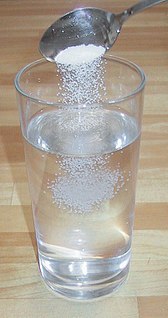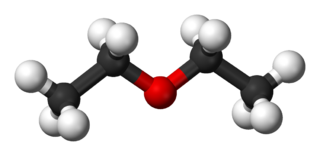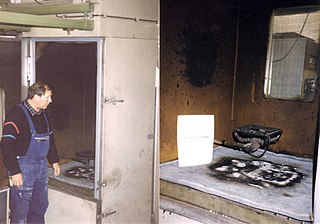Related Research Articles

Ammonia is a compound of nitrogen and hydrogen with the formula NH3. A stable binary hydride, and the simplest pnictogen hydride, ammonia is a colourless gas with a distinct pungent smell. It is a common nitrogenous waste, particularly among aquatic organisms, and it contributes significantly to the nutritional needs of terrestrial organisms by serving as a precursor to 45 percent of the world's food and fertilizers. Ammonia, either directly or indirectly, is also a building block for the synthesis of many pharmaceutical products and is used in many commercial cleaning products. It is mainly collected by downward displacement of both air and water.

A molecular cloud, sometimes called a stellar nursery (if star formation is occurring within), is a type of interstellar cloud, the density and size of which permit absorption nebulae, the formation of molecules (most commonly molecular hydrogen, H2), and the formation of H II regions. This is in contrast to other areas of the interstellar medium that contain predominantly ionized gas.

Stoichiometry refers to the relationship between the quantities of reactants and products before, during, and following chemical reactions.

In chemistry, a solution is a special type of homogeneous mixture composed of two or more substances. In such a mixture, a solute is a substance dissolved in another substance, known as a solvent. The mixing process of a solution happens at a scale where the effects of chemical polarity are involved, resulting in interactions that are specific to solvation. The solution usually has the state of the solvent when the solvent is the larger fraction of the mixture, as is commonly the case. One important parameter of a solution is the concentration, which is a measure of the amount of solute in a given amount of solution or solvent. The term "aqueous solution" is used when one of the solvents is water.
The mole (symbol: mol) is the base unit of amount of substance in the International System of Units (SI). It is defined as exactly 6.02214076×1023 particles, which may be atoms, molecules, ions, or electrons.

A solvent is a substance that dissolves a solute, resulting in a solution. A solvent is usually a liquid but can also be a solid, a gas, or a supercritical fluid. Water is a solvent for polar molecules and the most common solvent used by living things; all the ions and proteins in a cell are dissolved in water within the cell.

Liquid hydrogen (LH2 or LH2) is the liquid state of the element hydrogen. Hydrogen is found naturally in the molecular H2 form.
Graham's law of effusion was formulated by Scottish physical chemist Thomas Graham in 1848. Graham found experimentally that the rate of effusion of a gas is inversely proportional to the square root of the molar mass of its particles. This formula can be written as:
In chemistry, the molar mass of a chemical compound is defined as the mass of a sample of that compound divided by the amount of substance in that sample, measured in moles. The molar mass is a bulk, not molecular, property of a substance. The molar mass is an average of many instances of the compound, which often vary in mass due to the presence of isotopes. Most commonly, the molar mass is computed from the standard atomic weights and is thus a terrestrial average and a function of the relative abundance of the isotopes of the constituent atoms on Earth. The molar mass is appropriate for converting between the mass of a substance and the amount of a substance for bulk quantities.
In chemistry, the amount of substance in a given sample of matter is defined as the number of discrete atomic-scale particles in it divided by the Avogadro constant NA. In a truly atomistic view, the amount of substance is simply the number of particles that constitute the substance. The particles or entities may be molecules, atoms, ions, electrons, or other, depending on the context. The value of the Avogadro constant NA has been defined as 6.02214076×1023 mol−1. In the truly atomistic view, 1 mol = 6.02214076×1023 particles (the Avogadro number) and therefore the conversion constant is simply NA = 1. The amount of substance is sometimes referred to as the chemical amount.

Diethyl ether, or simply ether, is an organic compound in the ether class with the formula (C
2H
5)
2O, sometimes abbreviated as Et
2O. It is a colorless, highly volatile, sweet-smelling, extremely flammable liquid. It is commonly used as a solvent in laboratories and as a starting fluid for some engines. It was formerly used as a general anesthetic, until non-flammable drugs were developed, such as halothane. It has been used as a recreational drug to cause intoxication. It is a structural isomer of butanol.
The molar heat capacity of a chemical substance is the amount of energy that must be added, in the form of heat, to one mole of the substance in order to cause an increase of one unit in its temperature. Alternatively, it is the heat capacity of a sample of the substance divided by the amount of substance of the sample; or also the specific heat capacity of the substance times its molar mass. The SI unit of specific heat is joule per kelvin per mole, J⋅K−1⋅mol−1.

Acetone, or propanone, is an organic compound with the formula (CH3)2CO. It is the simplest and smallest ketone. It is a colourless, highly volatile and flammable liquid with a characteristic pungent odour.
Mixtures of dispersed combustible materials and oxygen in the air will burn only if the fuel concentration lies within well-defined lower and upper bounds determined experimentally, referred to as flammability limits or explosive limits. Combustion can range in violence from deflagration through detonation.

A combustible material is something that can combust (burn) in air. Flammable materials are combustible materials that ignite easily at ambient temperatures. In other words, a combustible material ignites with some effort and a flammable material catches fire immediately on exposure to flame.
Hydrogen safety covers the safe production, handling and use of hydrogen - particularly hydrogen gas fuel and liquid hydrogen. The main concern in working with hydrogen is flammability.

Gas is one of the four fundamental states of matter.
A lifting gas or lighter than air gas is a gas that has a lower density than normal atmospheric gases and rises above them as a result. It is required for aerostats to create buoyancy, particularly in lighter-than-air aircraft, which include free balloons, moored balloons, and airships. Only certain lighter than air gases are suitable as lifting gases. Dry air has a density of about 1.29 g/L at standard conditions for temperature and pressure (STP) and an average molecular mass of 28.97 g/mol, and so lighter than air gases have a density lower than this.
The Glossary of fuel cell terms lists the definitions of many terms used within the fuel cell industry. The terms in this fuel cell glossary may be used by fuel cell industry associations, in education material and fuel cell codes and standards to name but a few.
Gas blending is the process of mixing gases for a specific purpose where the composition of the resulting mixture is specified and controlled. A wide range of applications include scientific and industrial processes, food production and storage and breathing gases.
References
- ↑ MSDS Glossary of Terms – Vapour Density. Msdsonline.com. Retrieved on 2012-02-09.
- ↑ HazMat Math: Calculating Vapor Density Archived 2011-07-11 at the Wayback Machine . Firenuggets.com. Retrieved on 2012-02-09.
- ↑ MSDS: Acetone. Hazard.com (1998-04-21). Retrieved on 2012-02-09.
- ↑ NIOSH Pocket Guide: Acetone. Cdc.gov. Retrieved on 2012-02-09.